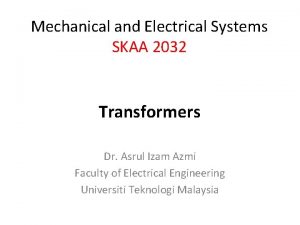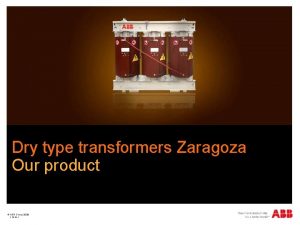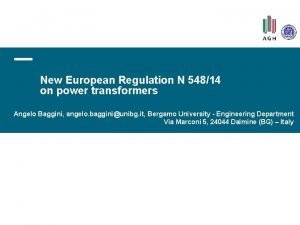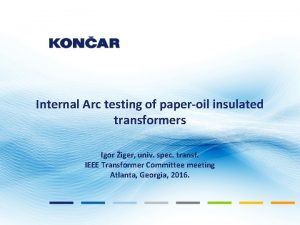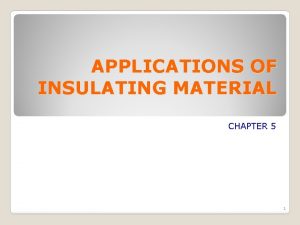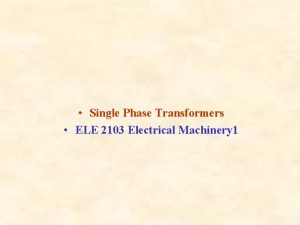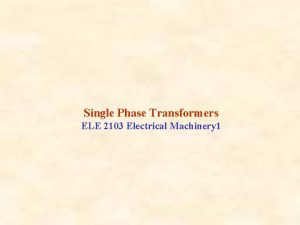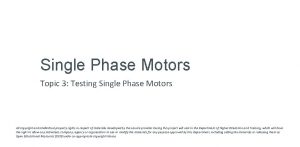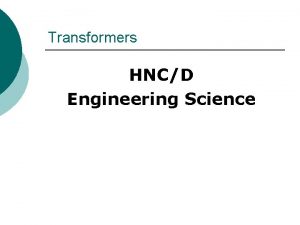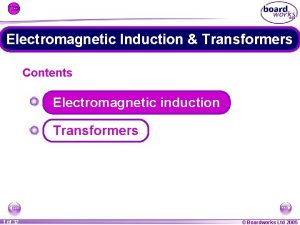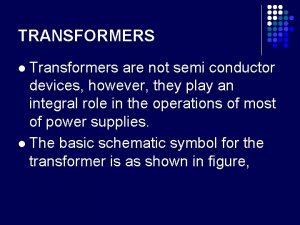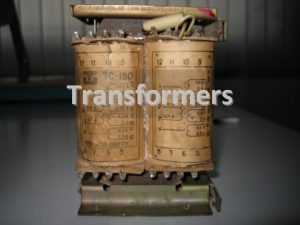Transformers Transformers AC Single Phase Three Phase ELE










![Exercise [1] A 250 k. VA, 11000 / 415 V, 50 Hz, single phase Exercise [1] A 250 k. VA, 11000 / 415 V, 50 Hz, single phase](https://slidetodoc.com/presentation_image_h2/4b7f1740917b30ae7eef57f6fba8e251/image-11.jpg)

- Slides: 12

Transformers • Transformers Ø AC (Single Phase, Three Phase) ELE 2103 Dept. of E & E, MIT Manipal

Single phase Transformer • • • Introduction to Transformers Classifications Representation Principle of Operation Constructional Features Emf Equation & Exercise Ideal Transformer Practical Transformer Summary ELE 2103 Dept of E & E, MIT Manipal

Introduction • Applications Ø Electric power systems ü Power transmission, Distribution Networks Ø Electronic Circuits Ø Electric Traction Ø Special Applications ELE 2103 Dept of E & E, MIT Manipal

Classifications • No. of Phases ü Single Phase, Three Phase • Construction ü Core Type, Shell Type • Functional ü Step up, Step down • Power level ü Power, Distribution Transformers • No. of Windings ü One winding, Two winding, Three winding • Special Transformers ü Instrument, Isolation, Pulse, Constant Voltage ü High Frequency, Phase Changing ELE 2103 Dept of E & E, MIT Manipal

Representation Core Supply side V 1 V 2 Load side N 1 N 2 Primary Side N 1 = Number of turns on primary Secondary Side N 2 = Number of turns on secondary ü Static Device working on principle of electromagnetic induction ü Energy transfer from one circuit to another without change in frequency ü Electric Circuits linked by common magnetic core ELE 2103 Dept of E & E, MIT Manipal

Operation I 1 V 1 • • • Ø E 2 E 1 Magnetic Core : Flux path Flux Linkages : Primary & Secondary Induced Emf : Primary – Self Induced Emf & Secondary – Mutually Induced Emf ELE 2103 I 2 Dept of E & E, MIT Manipal V 2 LOAD

Construction – Core Type LV winding Insulation HV winding Yoke Limbs Laminations Core Winding crossover Primary & Secondary windings ELE 2103 Dept of E & E, MIT Manipal

Construction - Shell Type Yoke LV winding Insulation HV winding Central Limb Side Limbs Laminations Yoke Core Insulation Secondary Winding Terminals ELE 2103 Dept of E & E, MIT Manipal

emf equation ELE 2103 Dept of E & E, MIT Manipal

Transformer Ratios (Transformation Ratio) N 2 < N 1 : Step Up N 2 = N 1 : 1: 1 type V 1 N 2 E 2 < E 1 V 2 < V 1, I 1 < I 2 ELE 2103 V 2 V 1 N 2 < N 1 : Step down type V 2 V 1 E 2 = E 1 V 2 = V 1, I 1 = I 2 Dept of E & E, MIT Manipal V 2 E 2 < E 1 V 2 < V 1, I 1 < I 2
![Exercise 1 A 250 k VA 11000 415 V 50 Hz single phase Exercise [1] A 250 k. VA, 11000 / 415 V, 50 Hz, single phase](https://slidetodoc.com/presentation_image_h2/4b7f1740917b30ae7eef57f6fba8e251/image-11.jpg)
Exercise [1] A 250 k. VA, 11000 / 415 V, 50 Hz, single phase transformer has 80 turns on the secondary. Determine (a) rated primary and secondary currents (b) primary turns (c) maximum flux (d) emf induced per turn Ans: (a) 22. 73 A, 602. 41 A (b) 2120 turns (c) 23. 37 m. Wb (d) 5. 1886 Volts / turn ELE 2103 Dept of E & E, MIT Manipal

Summary • Transformers : Importance, Applications, Classifications • Two winding representation • Principle of Operation • Constructional Features : Core type, Shell type • Emf Equation, Transformation Ratios • Ideal Transformer • Practical Transformer ELE 2103 Dept of E & E, MIT Manipal




